Antique Moving Signed Miniature High Detailed Gun Musket Rifle Scale Handmade
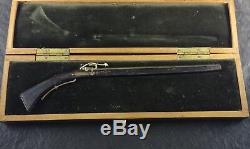
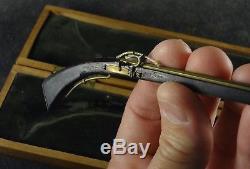
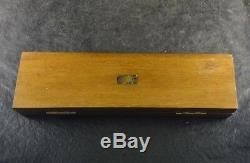
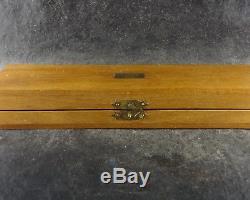
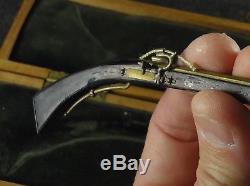
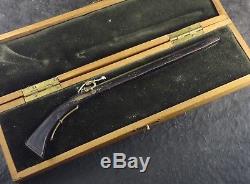
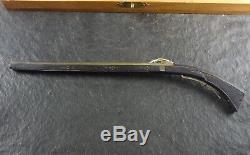
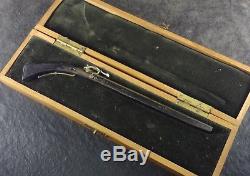
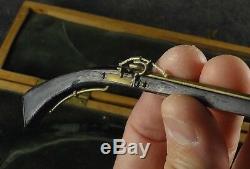
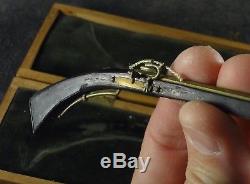

SEE MORE COLLECTABLE GUN MINIATURES HERE. ITEM DESCRIPTION IS AT THE END OF THIS ARTICLE.
Miniatures hold a fascination for everyone. Perhaps it is something rooted in the happy memories of our childhood toys. As we mature and grow in sophistication we begin to appreciate the huge amount of skill required to make things small. The craftsmen who create miniature firearms and ammunition do it for the challenge and the artistic satisfaction.
Only a handful of master miniature makers have ever been able to make a living doing it. For most hobby builders, there is virtually no financial incentive. This work is labor intensive and generally each piece is unique. Since medieval times, journeyman artisans have made miniature weapons as demonstrations of mastery in their trades. Miniatures were also made as easily transportable sales samples.
The majority, then as now, were created as art objects for personal enjoyment and for wealthy patrons. In 1973 the Miniature Arms Society (MAS) was established to bring builders, collectors and enthusiasts together in the tiniest niche of the arms collecting hobby. Based in the United States, the club has about 300 members worldwide.
They share a common appreciation for artistry and fine craftsmanship. The art is not solely in the decoration of the miniatures, though some are magnificently embellished with engraving, stock carving and precious metal inlays just like real firearms. A large part of the artistic achievement is in the technical mastery needed to recreate a full-sized object in miniature. You dont need to be an artist to join MAS; you just need to like miniature arms. Neophyte collectors and builders will find wide and enthusiastic support from fellow members.Every year since its founding, club members exhibit examples of their best pieces at the NRA Annual Meetings and Exhibits. The miniature arms hobby is as broad in historical scope and variety as the arms industry itself and includes everything from bows and edged weapons to artillery. Firearms make up the largest portion of the hobby and span muzzleloaders to machine guns, with Colt revolvers and Winchester lever-action rifles being the most popular. Some makers produce scale live ammunition with which to fire their tiny guns. Miniatures are not considered firearms unless they are chambered in a commonly available cartridge, like.
Miniature cartridge-powder charges and bullet weights are scaled back to match the size of the weapon, which sometimes results in velocities that are too low for accurate fire despite the efforts of builders to cut precisely scaled rifling into their barrels. Some makers work traditionally, you might say even primitively, measuring and scaling with mechanical instruments and using tiny hand-made tools. Others use sophisticated computer numerically controlled (CNC) machines to cut each piece and 3D printers to make molds for casting parts.Between these two poles there are a lot of little manual lathes and tabletop milling machines tucked into garages and basements where talented amateur and professional machinists test their skills making these little weapons. Each miniature gun project requires careful hand finishing.
The parts must be fitted and polished, and all the subtle surface details recreated, including any markings and decoration if desired, before they are hardened and given their final surface touch. A great deal of the work needs to be done under magnification. Consider how small the decorative engraving on a one-eighth scale pistol would be and you will understand why working under a microscope is necessary.
The most popular among collectors are those in one-third and one-fourth scale, which can retain complete functionality and sometimes even fire custom-made miniature live ammunition. Miniatures that fire conventional ammunition, usually half scale, are treated as pistols under federal and state law.
As the scale shrinks below one-quarter, it becomes increasingly difficult to fashion moving parts and some function is often lost. Certainly full functionality is possible in the smaller scales, but that kind of tiny precision work can get as physically delicate as a watch movement and very expensive. MAS member, director, and advanced collector Ted Campbell Sr. Explained, The smaller the scale gets, the greater the skill required to build it. Thats why one of the favorites in his collection, which hovers around 60 pieces, is an amazing one-eighth scale brace of 1851 Colt Navy revolvers in a fitted case with tools made by the late George Jones, a renowned miniature firearms maker.Each fully operable pistol measures only slightly more than 1¾ inches. Also among Campbells favorites are two machine-gun miniatures.
His tiny one-fifth scale MAC-10 machine pistol was superbly recreated by an unknown maker. It lacked only the logo and markings, which Campbell had engraved by Roger Sampson, a known master engraver. It is not uncommon for builders to collaborate on projects.
Campbells miniature World War II British Sten MK2 submachine gun made by Leon Crottet of Switzerland actually fires in full-auto mode. However, since it uses a completely unique and custom-made miniature cartridge, it is not subject to the National Firearms Act (NFA) regulations that a genuine 9mm Sten would be. One significant aspect of the miniature arms hobby centers is on pinfire guns.These popular novelty pieces have been in production continuously since the late 19th century and include replicas of period weapons, as well as unique designs. They were handmade as well as mass-produced examples.
Unlike other miniatures, all pinfire guns are intended to fire blanks, live ammunition or sometimes both. Their tiny cartridge cases are straight cylinders, sealed on one end, from which a miniscule pin protrudes. When the miniature guns hammer strikes, it drives the pin into a primer within the case to ignite the main powder charge.Loaded with a lead bullet about the size of a number 9 shotgun pellet, the popular 2mm pinfire round is about. 078 inches wide and less than a quarter inch long. They are about as loud as cap guns, and were never really considered serious defensive weapons. A Victorian-era gentleman might use one as a fob at the end his watch chain to delight children. Quality of workmanship is the single most important factor in establishing value, followed by relative rarity.
The closest thing to production-made miniatures are those produced by Miniart in Russia (now out of business) and Aldo Uberti S. Famous for their full-sized replicas of 18th century Colts, in Italy. Though they are of excellent quality and workmanship, they are also in relative abundance compared to the work of master craftsman David Kucer of Montreal, Canada, Fred Crissman of Pennsylvania or the late Tom Weston of Mexico City, Mexico. The value of any miniature is enhanced by the appropriate accoutrements. Examples include fitted French cases with their numerous compartments, bullet molds, powder flasks, holsters, slings, silencers, cartridges and even manuals. The making of a miniature gun requires broad talents. Virtually every part of it must be fabricated from scratch.You dont necessarily need to be a gunsmith, but the gunsmiths skilled hands and affinity for the mechanical are prerequisites for making a gun of any kind. Many miniatures past and present have been created with just hand tools.
To sculpt, checker, decoratively carve grips and stocks and build fitted cases, woodworking is required. Those fitted cases were always equipped with locks so you might find yourself becoming a locksmith along the way.
Many novice builders start with Derringers because of their mechanical simplicity. A Remington single-shot, vest-pocket Derringer was MAS member Bob McGinnis first successful project, and it took him 100 hours of work to complete. Since then hes made a literal handful of Derringers and wants to move on to more advanced projects like a Remington rolling-block rifle. Though McGinnis started building the traditional way, he is not your typical miniature builder.
He began working in the tool and die trade in 1959 and spent 25 years in his own shop building precision-injection molds for the plastics industry before retiring and passing the business to his son. He didnt know there were miniature gun makers until 1989 when he read an article inGun Digest. He joined MAS in 1993, and through its members gained access to a huge body of invaluable institutional knowledge and building experience. Reflecting on his 22 years in MAS, he told me, I had the pleasure and good fortune to learn from some of the finest craftsmen in the world, and hope someday I can pass on what I learned to younger craftsmen and artisans so they can carry on this wonderful art and hobby. By contrast, 92-year-old David Kucer knew he wanted to make miniature guns since childhood.
He first saw them as part of a traveling show while on a family trip to New York City in 1935. Coming from a family of metal workers and having access to tools in his fathers shop, he made his first admittedly primitive mini when he was 12, with a barrel fabricated from a piece of a quarter-inch bar stock he scrounged in a junkyard. That first project showed him that he lacked both the right tools and sufficient skill. By the early 1950s he had both.His interest in miniature firearms was forced to lie dormant while he finished high school, worked in the family business and served his country in the Canadian Army as an armament artificer from 1942 to 1946. His first satisfying miniature gun was a one-quarter scale M1911, like the one he carried throughout the war.
During the process of building this first piece, he designed and built each tool, which he continues to use to this day. The bulk of the metal work is done on his one-third scale custom vertical mill and a pantograph-engraving machine he modified to cut parts into three dimensions. A pantograph is used to accurately trace the shapes of parts while simultaneously.
In his 60-year career hes made 80 different miniature gun projects totaling over 400 pieces, most of them built after 1970 when he went into business for himself. By 1975 he was building miniature guns full time and was eventually joined by his son, Zavie, who works by his side every day. Customers expect to wait a year between creations, as his work is of such extraordinary excellence it has been exhibited in seven museums, including the Royal Ontario Museum, the Royal Armouries of H.
At the Tower of London, and most recently the Montreal Museum of Fine Art. You can see some of the work of David and Zavie Kucer and many other builders at the NRA Annual Meetings in Louisville, Ky. Next year or at the Craftsmanship Museum in Carlsbad, Calif. Where over 50 pieces are on loan from various makers and MAS collectors.
MAS publishes the Miniature Arms Journal quarterly for members and offers several publications for sale, including two by MAS journal editor Bob Urso: The Tiniest Guns and The Odd & Curious Guns, Knives and Drawings of Herschel Kopp. The former is a detailed catalog of historic pinfire guns and the latter is a wealth of information for new builders. This is a new old stock gun miniature. Crafted y E Ruiz during in Spain during 1950s. Exactly miniature reproduction (6.1/2 inches long).Amazing hand work with wood, metal & decoration to reproduce the exactly look of the original musket. Very ornate, exquisite & high detailed piece. Amazing & intricate piece in superb condition. This artist only made 340 gun miniatures reproduction during is life and he never make the same model twice.
Includes original signed wooden box. All defects not mentioned but visible in the pictures will be considered as described. If you have any question, do not hesitate to contact me. Thank you for your visit. The item "ANTIQUE MOVING SIGNED MINIATURE HIGH DETAILED GUN MUSKET RIFLE SCALE HANDMADE" is in sale since Wednesday, October 24, 2018. This item is in the category "Collectibles\Decorative Collectibles\Miniatures". The seller is "liancollect" and is located in Buenos Aires, Buenos Aires. This item can be shipped worldwide.- Brand: E Ruiz
- Type: Miniature Gun
- Country/Region of Manufacture: Spain
- Modified Item: No

